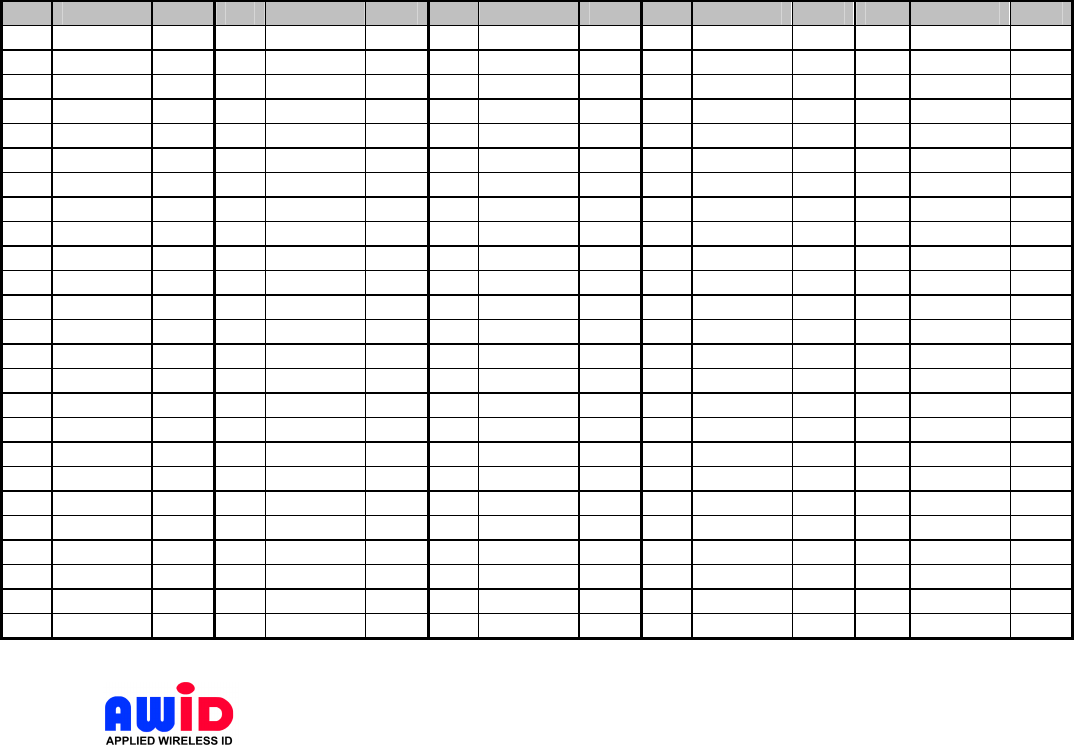Applied Wireless Identifications Group MPR1910 MPR-1910 RFID Reader Module User Manual 1
Applied Wireless Identifications Group Inc. MPR-1910 RFID Reader Module 1
User manual

MPR-1910 - 1 - 9/21/2009
SENTINEL-SENSE MPR-1910
Installation & Operation Manual-041396

MPR-1910 - 2 - 9/21/2009
COPYRIGHT ACKNOWLEDGEMENTS
The contents of this document are the property of Applied Wireless Identifications Group, Inc.
(AWID) and are copyrighted. All rights reserved. Any reproduction, in whole or in part, is
strictly prohibited. For additional copies of this document please contact:
AWID
18300 Sutter Blvd
Morgan Hill, CA 95037
http://www.AWID.com
The information contained herein has been carefully checked and is believed to be accurate,
no responsibility is assumed for inaccuracies. AWID reserves the right to make changes
without prior notice. This document is not covered by any warranty either expressed or
implied. Any comments, corrections or additions to the contents of this document should be
directed to AWID at the above address.
Copyright 2009 AWID, Printed in USA.
All other trademarks are the property of their respective owners.
FCC COMPLIANCE
You are cautioned that changes or modifications not expressively approved by the party
responsible for compliance could void you authority to operate the equipment.
FCC RF Radiation Exposure Statement:
1. This Transmitter must not be co-located or operating in conjunction with any other antenna or
transmitter.
2. This equipment complies with FCC RF radiation exposure limits set forth for an uncontrolled
environment. This equipment should be installed and operated with a minimum distance of 20
centimeters between the radiator and your body.
Information for OEM integrator:
The OEM integrator has to be aware not to provide information to the end user regarding how
to install or remove this RF module in the user manual of the end product. The user manual
which is provided by OEM integrators for end users must include the following information in a
prominent location.
“To comply with FCC RF exposure compliance requirements, the antenna used for this
transmitter must be installed to provide a separation distance of at least 20 cm from all persons
and must not be co-located or operating in conjunction with any other antenna or transmitter. If
the end product integrating this module is going to be operated in 5.15 ~5.25GHz frequency
range, the warning statement in the user manual of the end product should include the
restriction of operating this device in indoor could void the user’s authority to operate the
equipment.”
Label for end product must include “Contains FCC ID: OGSMPR1910” or “A RF
transmitter inside, FCC ID: OGSMPR1910”.
The user is cautioned that this device should be used only as specified within this manual to
meet RF exposure requirements. Use of this device in a manner inconsistent with this manual
could lead to excessive RF exposure conditions.

MPR-1910 - 3 - 9/21/2009
Table of Contents
REVISION HISTORY .......................................................................................................4
INTRODUCTION..............................................................................................................5
1.1 Special Features ................................................................................................5
2 SPECIFICATIONS ....................................................................................................6
2.1 Channel Frequency Table..................................................................................6
2.2 Connector Pin Assignment.................................................................................7
2.3 Measuring Read Distance..................................................................................7
3 INSTALLATION & OPERATION GUIDELINES .......................................................8
3.1 General Wiring Requirements............................................................................8
3.2 Parts List............................................................................................................9
3.3 Preparation for Installation .................................................................................9
3.3.1 Bench Top Verification................................................................................9
4 SOFTWARE PROGRAMMING AND SYSTEM OPERATION NOTES...................10
4.1 System Operation ............................................................................................10
4.1.1 Running a Custom Software Application or the AWID Demo Program.....10
4.1.2 Operating Modes ......................................................................................10
4.2 Users Note.......................................................................................................10
5 MPR SERIAL COMMUNICATION PROTOCOL.....................................................11
NOTE: READ AND USE THIS MANUAL.
NOTE: FAILURE TO FOLLOW THE INSTALLATION GUIDE MAY RESULT IN
POOR PERFORMANCE OR EVEN CAUSE PERMANENT DAMAGE TO THE
READER, THUS VOIDS THE PRODUCT WARRANTY.

MPR-1910 - 4 - 9/21/2009
REVISION HISTORY
Version
No.
Revised
By
Date Sections
Affected
Remarks
0.1 E. Wei 10/2008 - Initial version
0.2 E. Wei 7/2009 - Engineering review update
0.3 E. Wei 9/2009 p. 2 Compliance section added

MPR-1910 - 5 - 9/21/2009
INTRODUCTION
AWID's Sentinel-Sense MPR-1910 is a long-range (up to 20 feet) Radio Frequency
IDentification (RFID) reader module with 3.3 V TTL logical interface that works with most
leading passive UHF passive tags. The reader module comes with a unique combination
of long read range, small size, and low power consumption. Its primary applications are
asset management and tracking, and fleet management applications.
MPR-1910 is delivered with Firmware Version such as 25.xx.xx.
In order to operate an MPR-1910 you will need the following:
PC running Windows1 2000 or higher, CD-ROM drive
Host software (AWID’s demo software or your own custom software)
1.1 SPECIAL FEATURES
• Multi-Protocol: ISO-18000-6 Type B/C, EPC Class 1 Gen 2
• Thin passive tags with long-range performance
• 3.3 V (5.0V tolerable) Serial TTL logical interface
•
1 Though MPR-1910 can also be controlled from a non-Windows programming platform, AWID demo and
FW upgrade programs are applications to run in Windows.

MPR-1910 - 6 - 9/21/2009
2 SPECIFICATIONS
Input voltage +4.5 VDC to +6.3 VDC (suggested: +6.0 VDC)
Input current 1.5 A typical in transmit
Protocol language ISO Type B/C, EPC Class 1 Gen 2
Read range Depends on type & size of labels used
Output power +30 dBm max
Transmit frequency 902.60-927.40 MHz
Receiver frequency 902.60-927.40 MHz (Amplitude Modulated)
Hopping channels 125 Channels
Channel spacing 200 kHz
Hopping sequence Pseudo random
Operating temperature range -30° C to +55° C (-22° F to 131° F)
Output data formats 3.3V TTL Serial
I/O Connector 10-pin ZIF
Dimension 2.11”x3.31”x0.35”
2.1 CHANNEL FREQUENCY TABLE
Frequency range: 902.60 ~ 927.40 MHz
Minimum number of frequency channels: 125
CH
902~928
MHz
CH
902~928
MHz
CH
902~928
MHz
CH
902~928
MHz
CH 902~928
MHz
0
902.60
MHz
25
907.60
MHz
50
912.60
MHz
75
917.60
MHz
100
922.60
MHz
1
902.80
MHz
26
907.80
MHz
51
912.80
MHz
76
917.80
MHz
101
922.80
MHz
2
903.00
MHz
27
908.00
MHz
52
913.00
MHz
77
918.00
MHz
102
923.00
MHz
3
903.20
MHz
28
908.20
MHz
53
913.20
MHz
78
918.20
MHz
103
923.20
MHz
4
903.40
MHz
29
908.40
MHz
54
913.40
MHz
79
918.40
MHz
104
923.40
MHz
5
903.60
MHz
30
908.60
MHz
55
913.60
MHz
80
918.60
MHz
105
923.60
MHz
6
903.80
MHz
31
908.80
MHz
56
913.80
MHz
81
918.80
MHz
106
923.80
MHz
7
904.00
MHz
32
909.00
MHz
57
914.00
MHz
82
919.00
MHz
107
924.00
MHz
8
904.20
MHz
33
909.20
MHz
58
914.20
MHz
83
919.20
MHz
108
924.20
MHz
9
904.40
MHz
34
909.40
MHz
59
914.40
MHz
84
919.40
MHz
109
924.40
MHz
10
904.60
MHz
35
909.60
MHz
60
914.60
MHz
85
919.60
MHz
110
924.60
MHz
11
904.80
MHz
36
909.80
MHz
61
914.80
MHz
86
919.80
MHz
111
924.80
MHz
12
905.00
MHz
37
910.00
MHz
62
915.00
MHz
87
920.00
MHz
112
925.00
MHz
13
905.20
MHz
38
910.20
MHz
63
915.20
MHz
88
920.20
MHz
113
925.20
MHz
14
905.40
MHz
39
910.40
MHz
64
915.40
MHz
89
920.40
MHz
114
925.40
MHz
15
905.60
MHz
40
910.60
MHz
65
915.60
MHz
90
920.60
MHz
115
925.60
MHz
16
905.80
MHz
41
910.80
MHz
66
915.80
MHz
91
920.80
MHz
116
925.80
MHz
17
906.00
MHz
42
911.00
MHz
67
916.00
MHz
92
921.00
MHz
117
926.00
MHz
18
906.20
MHz
43
911.20
MHz
68
916.20
MHz
93
921.20
MHz
118
926.20
MHz
19
906.40
MHz
44
911.40
MHz
69
916.40
MHz
94
921.40
MHz
119
926.40
MHz
20
906.60
MHz
45
911.60
MHz
70
916.60
MHz
95
921.60
MHz
120
926.60
MHz
21
906.80
MHz
46
911.80
MHz
71
916.80
MHz
96
921.80
MHz
121
926.80
MHz
22
907.00
MHz
47
912.00
MHz
72
917.00
MHz
97
922.00
MHz
122
927.00
MHz
23
907.20
MHz
48
912.20
MHz
73
917.20
MHz
98
922.20
MHz
123
927.20
MHz
24
907.40
MHz
49
912.40
MHz
74
917.40
MHz
99
922.40
MHz
124
927.40
MHz
Table 1 Channel Frequency Table for MPR-1910

MPR-1910 - 7 - 9/21/2009
2.2 CONNECTOR PIN ASSIGNMENT
Pin Function Pin Function
1 GPI 6 GND
2 GPO2 7 Unit Enable
3 GPO1 8 SCIR
4 +6.0 V 9 SCIT
5 +6.0 V 10 GND
2.3 MEASURING READ DISTANCE
Make sure you know the tag types. For certain readers and tags, user must also be
mindful of the tag’s orientation and the reader’s antenna orientation, what mounting
surface the tags are designed for and how the tags are supposed to be mounted. Any
departure from its intended purpose will drastically affect the reader’s ability to energize
the tag and its read range.
When measuring the reader’s read range, make sure that the tag is properly oriented to
the reader antenna, and for optimum performance, be sure the operator’s finger is not
within three (3) inches of the tag’s antenna surface.

MPR-1910 - 8 - 9/21/2009
3 INSTALLATION & OPERATION GUIDELINES
For ease of explanation, MPR reader in this section refers to an RFID device that
consists of MPR-1910 and a high performance circular polarized antenna inside a
splash proof, UV stabilized housing case. The module should be installed on a heat
sink. Example of a heat sink could be an aluminum plate of size 8”x8”x0.1” exposed to
convection air flow. The screws at the bottom of module shall be used for mounting the
module on the heat sink.
3.1 GENERAL WIRING REQUIREMENTS
MPR-19xx requires 10-pin flat flex cable (FFC) to connect from the supply source. Avoid
using long (e.g., 1” or longer) cables when connecting the unit from the power supply
source.

MPR-1910 - 9 - 9/21/2009
INSTALLATION PROCEDURE
This section provides installation and operation information for MPR-1980 reader modules.
3.2 PARTS LIST
Verify that all items listed below are present before starting the installation.
o Sentinel-Sense MPR-1910 Qty=1
o Documentation and command demo program CD Qty=1
3.3 PREPARATION FOR INSTALLATION
Familiarize yourself with the connectors and pin out assignment of each I/O connectors.
3.3.1 Bench Top Verification
It is always a good idea to verify system operation before committing to a full-scale
installation. The following are the necessary steps to test the reader’s operation in a
static environment.
Connect MPR-1910 to the RS-232 port of a PC through the interface board
provided in the demonstration kit
Connect the power jack from the wall plug power supply to reader module
Power up PC
Install demo software on PC
Activate demo software and verify performance of the reader.
Select COM port 1 on top page then click “Connect”. Follow with some
commands.

MPR-1910 - 10 - 9/21/2009
4 SOFTWARE PROGRAMMING AND SYSTEM OPERATION NOTES
4.1 SYSTEM OPERATION
4.1.1 Running a Custom Software Application or the AWID Demo Program
If AWID Demo Program is not used, it is expected user will launch a Custom Software
Application developed using the MPR Serial Communication Protocol II to issue
commands to the MPR reader/module as specified.
4.1.2 Operating Modes
Typical operating modes for MPR readers can be grouped into the following modes:
Search Mode
This mode is used when operator or user is not certain what family of tags is placed on
the items to be tracked. Since most tags are deterministic in nature, MPR reader must
cycle through each and every protocol, issue a protocol specific inquiry, to hail and to
wait for a response from tags of that specific protocol. Therefore, if there are many
different protocols, for an untrained observer, the reader response will appear sluggish.
Mixed Mode
This mode assumes the user is aware of the types of protocol in use, and furthermore, the
user made a determined effort to operate the reader in a mixed protocol mode. In this
mode, the user can decide how many and which specific protocols to be selected. Once
Mix Protocol Mode is selected, the reader will routinely cycle through each protocol, dwell
long enough for the reader to wait for a response and then move on to the next protocol. It
should be noted that in a mixed protocol mode, the tag must have sufficient time to
respond to the reader, and therefore, it can only be used on a conveyor belt arrangement,
with specific speed restrictions.
Single Protocol Mode
Single protocol is the normal mode of operation, where the protocol type is known and
many tags are expected to pass through the readers.
4.2 USERS NOTE
For System Integrators and/or Software Developers
System Integrators and/or software developers should get familiar with the MPR Serial
Communication Protocol II specifications for developing applications that control an
MPR-1980.
For Custom System Users
For custom system user, please refer to your host software user guide for information
regarding system and software operations
For Demo Software Users

MPR-1910 - 11 - 9/21/2009
If you are using the AWID RFID demonstration software application which is .NET based
with easy-to-follow GUI operations, simply select the COM port for which the MPR-1910
is configured then click “Connect” should get you started.
5 MPR SERIAL COMMUNICATION PROTOCOL
See MPR Serial Communication Protocol Manual II - 041377